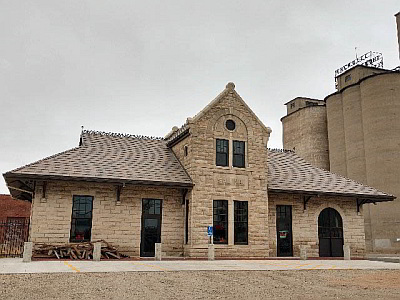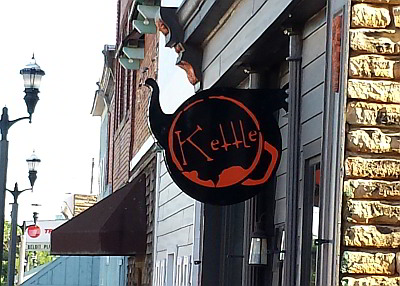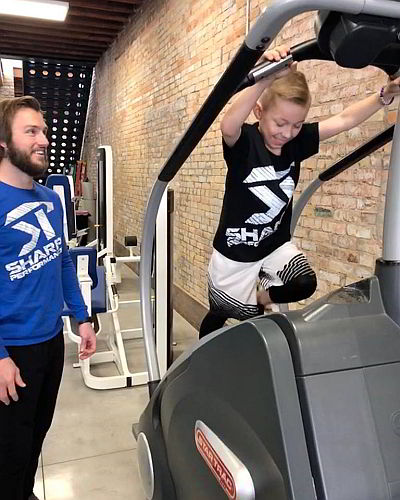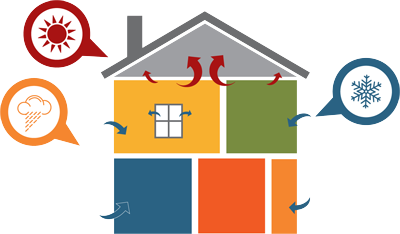 Congratulations to the 2019-2020 Rural Voices winners!
Congratulations to the 2019-2020 Rural Voices winners!
Jake Toole, Washington County High School
Julisa Wolf, Ell-Saline High School
The NCRPC sponsors the Rural Voices Youth Contest each year to engage high school seniors in North Central Kansas in thoughtful reflection on rural Kansas and to promote a discussion among citizens based on their insights. The 2019-2020 theme was “Rural Kansas…Rural by Choice.” Read the winning entries below.
The Reasons to Choose Rural Living
By Jake Toole
I’ve lived in Washington, Kansas nearly all of my life. It’s a nice little town with a population of around one thousand people. My parents made the choice to move to a small town when I was young because they believed I would benefit from rural living. Why did they make that choice when so many others do not? I believe the answer is that so many do not know what they are missing. To help new families choose rural life we must help them understand the benefits of rural living, we must show them that jobs can be found and created in our area, and we must persuade them that small-town life is the right choice for their children.
There are many benefits to rural living. All of my friends live within bike-riding distance of me. I know everyone in town, (or at least my parents do). I grew up with the benefits of having a yard – and so did every other kid in town, whether rich or poor (which, on a side note, means plenty of potential customers for my teenage mowing business). Plus we have large public parks, ball diamonds, and open areas to take advantage of. And if more space is needed, there’s always a friend’s farm to go hang out at or the state lake just down the road to have some good outdoor fun. My grandparents live “out of town” which is less than a 5-minute drive from my “in town” home. I can pop out anytime and be outside city limits, giving me a chance to let our dog run free, to practice target shooting or shoot fireworks in the summer at a moment’s notice. I can also drive to the grocery store, the gas station, or the pharmacy and be back home in less than 5 minutes. There is no such thing as traffic and no time is wasted sitting in rush hour on the way to work every day. Although time is often added to a “quick” trip because you run into someone who wants to ask about your latest endeavor at school or inquire if your grandpa got over his cold or if your Mom is enjoying her new flowers at the house. That’s what makes rural life so great – it is truly a community – a place where we have common interests, goals, and love for our shared lives.
Unfortunately promoting rural living has one big challenge: jobs, or rather the lack thereof. Young couples need the assurance of good jobs and who can blame them with student loans to repay, small children to care for and long-term savings to consider. According to the United States Census Bureau’s American Community Survey, the largest employment sector in Washington County is agriculture, the next largest is education and healthcare, and third is retail trade. According to Data USA, the number of employees in Washington County has declined by 1.55 percent from 2016 to 2017. While the job situation for our county may not look too bright, there are other options. Washington, Kansas, is about a half-hour away from several larger towns: Marysville to the east, Belleville to the west, Clay Center to the south, and Fairbury to the north. Although none of these towns are large by most standards, each has many more job opportunities both for blue-collar workers and for those with higher education. My father is a CPA and makes the twenty-minute commute every day to his accounting firm job in Marysville. This short commute, compared to 45 minutes in rush hour traffic, is a much more viable option for a young couple in need of a well-paying job. Allowing them to experience small-town life while working in a larger town. However, the commuter’s life is not the only option. Washington County is ripe with entrepreneurial opportunities. Our town has many small businesses that provide goods and services. If the service is needed a business can survive and thrive. One example is the hair salon industry – we have six independent hair salon businesses in our small town. Everyone needs to get their hair done. We have a family-owned grocery store that’s been serving our community for generations. There are also many stores around the area that provide services and supplies for farmers. These businesses also draw in customers from the rest of the county and beyond, helping to boost the local economy. Although these small businesses may not have a large customer base, they DO have very little competition. Entrepreneurs have a great opportunity to find a niche and focus on building a business, instead of undercutting the competition.
So how can we attract people to our community so they can experience all these benefits? I believe the answer lies in my parent’s example. My mother grew up in the same small town we live in now. When I was two years old, my parents agreed that sending me to a massive city school with class sizes of five-hundred or more was not what they wanted for me. They wanted me to know my classmates and to develop friendships with them over the years of my schooling. They wanted me to be well rounded by being involved in a variety of things in school. And most of all they wanted me to be an actual person to my teachers, instead of just another name to get to know for one year and then never really see again. All of this was possible when my parents decided to move to my mother’s hometown of Washington, Kansas. I’ve known my classmates since kindergarten. My grade school teachers still cheer me on at my high school cross country meets. I participate in band, chorus, art, forensics, scholar bowl, track and more. THIS is how we appeal to young couples – through their children. People will make the hard choices to move, to try new jobs, to leave malls, movie theatres, and sporting arenas if it means something better for their children. Let’s show them the opportunities that exist for their children in our small towns – to have a yard, to ride a bike in town, to know their neighbors, to walk a dog down the street. Let’s show them the opportunities for their children in our schools. The opportunities to truly know their classmates and teachers. The opportunities to allow their children to dip their toes into a variety of fields and activities, so they might truly find what they want to pursue. But how can we spread the word of all these great opportunities for small town living? I propose we advertise where the young couples are. Facebook ads are a great way to promote rural living as they can be targeted by age and location and are relatively cheap. I also propose radio advertising in large, metropolitan areas during rush hour traffic. What better time to convince listeners of the beauty of wide open spaces and a simpler life, than while they are sitting in a traffic jam on their way to work?
Obviously, rural living isn’t for everyone. But I believe that if more people knew all the benefits of small-town life for themselves and for their children, they would live rural by choice and never look back.
Rural Voices Youth Contest
By Julisa Wolf
When we, as teenagers, leave our homes to pursue our future careers in college or begin our time in the workforce, we tend to forget where our lives truly began. I believe that as we grow older, we reflect on all that we have accomplished and achieved. We ponder the great things we have received. We may have financial security, or we may also be well endowed with numerous items that show how wealthy we are. We may be recognized and revered by the community we live in. One might say that we are living our best lives. However, all of this fortune, comfort, and recognition means nothing, because there is a void inside ourselves that cannot be filled with tangible items. There is something that is missing, but we try not to pay attention and instead ignore it. We think that our money and considerable success will aid us in forgetting or ignoring the void, but it will always be there, until a change is made.
Over the course of my high school career, I have had the opportunity to hear some incredibly powerful stories of how people have managed to find their way back home to pursue their dreams where they grew up. I have been able to actively sit and listen to their vivid descriptions of how they got to their starting point that inevitably led them to their hometown. These deep and emotional narratives have impacted my life significantly.
A teacher of mine, we’ll call him Mr. Lyn, shared his story with our class. I looked forward to hearing his story because I thought of him as ancient and sage, for he was always willing to share his experiences so that others could learn from him. Mr. Lyn began his story by describing how successful he felt for graduating high school. Not long after, he moved away from his hometown to pursue a career in agriculture at a four-year university. Obtaining an agriculture degree was a dream he wanted to achieve since he was a young boy. Mr. Lyn’s ultimate goal was to make a difference somewhere by impacting the people around him to be better versions of themselves. He described his love for the experience he had and that he would most certainly do it again if given the opportunity. Nevertheless, he also shared that while he was gone, he felt alone and stressed. There was something inside him that just didn’t sit right. It was like a prickling on the back of his neck, a constant discomfort that never seemed to go away.
While in college, Mr. Lyn decided to further his passion for agriculture by becoming an educator because he wanted to share this passion of his with the younger generation. After graduating, he soon got a few jobs teaching around the state, but he still maintained close ties with the university he had attended. He was a very well liked man who was easily recognizable. His life was full of prosperous blessings, but still, despite all the attention he received, he could not stray away from the loneliness that burrowed in his heart and mind. Mr. Lyn wondered whether he needed to look at the world from different places. He thought to himself, perhaps this will fill his void? Maybe afterwards he would feel better and be able to continue, so he took on traveling. Although he had plenty of company and was genuinely enjoying himself around different countries, the sadness continued. He began to think that perhaps this wasn’t his purpose in life. All of the knowledge he had gained in school, all of the experiments and beautiful things done in college, he could no longer do. Every place he would travel to did not feel right for him. It was as though he did not fit in. Shortly after, he received disturbing news that his father was gravely ill. He returned home…only to bury him.
A few years after his father’s passing, he had an epiphany–he was no longer depressed. During these short years, he was hired at his alma mater, the very same place he graduated high school. He was teaching what he loved most–agriculture. He was given the opportunity to teach diverse students from ethnic backgrounds and learn both with and about them. Although Mr. Lyn returned home for unexpected and world-shattering reasons, there was a blessing hidden underneath the dark cloud. For he was able to continue sharing his passion for agriculture with students who he had common interests with. He immediately knew that this job was what he wanted to do, but most importantly it was where he belonged. As the years go by, Mr. Lyn’s story continues to inspire several of his students in the same manner in which I have been inspired. He taught us that sometimes, we do not need to travel the world to make a difference. Sometimes, the difference can be made in our own community.
Mr. Lyn set a goal for himself and achieved it. He educated us with the proper way to give back. Everyday we learn in class about what we can do for others around us and what that feels and looks like when we do things for others. For example, our annual canned food drive, we give food to local families in need during the holidays. Or our community garden, where we gather fruits and vegetables to donate to our school cafeteria for lunch. With his knowledge and kind heart, he has helped provide several amazing things to his community table that go beyond the examples previously described.
In conclusion, to reiterate the Rural Kansas question, what can be done in our communities for people to want to come or return? What challenges must be overcome to encourage others to be rural? The first step is that we need to have faith in ourselves and determine and set goals. The steps taken to get to the end goal aren’t as important as meeting the needs of our community. The second step is that we must learn to collaborate as a community so that we can easily recognize and address the highest needs of our rural areas. In every place we choose to settle down in, there will always be something that we can help with. No matter the profession, no matter the person, the amount of work is endless. One possible solution to the challenges that need to be overcome is by making our communities more friendly and welcoming. By making the community approachable, comfortable, and at-ease, it shows people that anything they contribute is useful and resourceful. The people of the community need to feel as though the location where they choose to make a difference, suits them. They need to feel that they belong.
The next contest deadline will be December 1, 2020. Check back in the fall for details on the 2020-2021 Rural Voices Youth Contest.



 Once eligible, participants can open a special savings account that is eligible for a 2:1 match for every dollar saved, up to $3,000. For example, $3,000 in savings will be matched with $6,000 for a total of $9,000. Accrued savings can be used to purchase a first home, pay for home repairs, open a small business, or pay for college or specialized training.
Once eligible, participants can open a special savings account that is eligible for a 2:1 match for every dollar saved, up to $3,000. For example, $3,000 in savings will be matched with $6,000 for a total of $9,000. Accrued savings can be used to purchase a first home, pay for home repairs, open a small business, or pay for college or specialized training.



